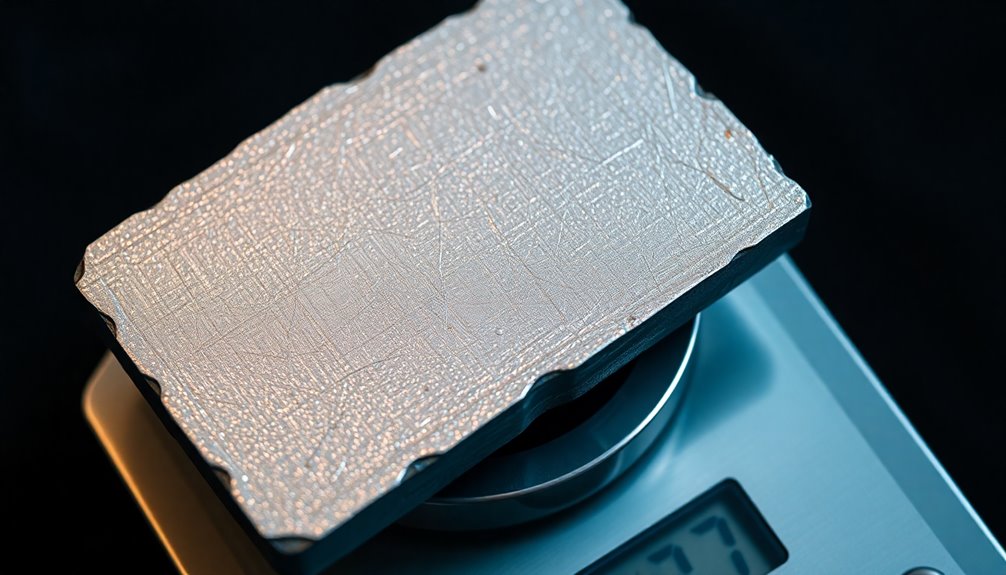If you're searching for the lightest but strongest metal, titanium is your answer. It boasts an impressive strength-to-weight ratio, making it 45% lighter than steel while remaining incredibly strong. This metal is often used in aerospace engineering and medical implants due to its unique properties. It's perfect for applications where reducing weight is essential without sacrificing strength. There's much more to uncover about its applications and benefits, so let's explore further!
Key Takeaways
- Titanium is regarded as the lightest but strongest metal, with a high strength-to-weight ratio.
- It is 45% lighter than steel, making it ideal for aerospace applications.
- Magnesium is the lightest structural metal, but has a lower strength-to-weight ratio than titanium.
- Aluminum is lightweight and more economical, suited for applications where extreme strength isn't critical.
- Cost considerations often lead to selecting aluminum or magnesium over titanium despite its superior properties.

When it comes to finding the ideal balance between weight and strength, titanium stands out as a remarkable choice. You might be surprised to learn that titanium is often considered the lightest but strongest metal available. With a high strength-to-weight ratio, it's about 45% lighter than steel while maintaining comparable strength. This impressive characteristic makes titanium a favorite in industries where both weight and strength are paramount, such as the aerospace industry.
While titanium shines regarding strength, don't overlook magnesium, which is the lightest structural metal. Weighing two-thirds that of aluminum, magnesium offers good strength but doesn't fully match the strength-to-weight ratio of titanium alloys.
Aluminum, with a density of 2.7 g/cm³, also boasts lightweight properties, exhibiting excellent strength and corrosion resistance. This makes aluminum a popular choice across various industries, from automotive to construction.
However, when you weigh the options, titanium's lightweight properties and superior strength become clear advantages, especially in critical applications like aerospace and medical implants. In these fields, the ability to reduce weight while ensuring structural integrity can make all the difference. The strength-to-weight ratio of titanium alloys allows for thinner designs without compromising on strength, enabling engineers to create innovative solutions that push the boundaries of what's possible.
That said, the superior properties of titanium come at a cost. It's notably more expensive than both aluminum and magnesium, which can limit its use in some applications.
While you may find yourself drawn to titanium's impressive features, consider the trade-offs in budget constraints. For applications where weight and strength aren't as critical, aluminum or magnesium may provide a more economical alternative without sacrificing too much regarding performance.
Frequently Asked Questions
What Is the Lightest Metal but Strongest?
When you think about the lightest metal with great strength, magnesium often comes to mind.
It's about 33% lighter than aluminum and still holds up well in various applications.
While titanium offers impressive strength, it's heavier than magnesium.
If you're looking for alternatives, consider aluminum alloys, which provide a good balance of lightweight properties and strength.
What Is the Strongest Metal Discovered?
Imagine a knight clad in armor, fiercely protecting his kingdom. In the domain of metals, tungsten takes on that knightly role, boasting an unmatched ultimate tensile strength of about 1510 MPa.
You can see how it stands resilient against deformation, a true champion of durability. While it's dense and heavy, titanium alloys emerge as lighter warriors, offering impressive strength too.
Ultimately, tungsten reigns supreme in the world of metals, unmatched in pure strength.
What Is the Cheapest but Strongest Metal?
When you're looking for the cheapest but strongest metal, low-carbon steel often fits the bill.
At around $0.20 to $0.50 per pound, it's widely available and offers considerable strength.
Aluminum is another option; though slightly pricier at $1.5 to $3 per pound, it boasts a great strength-to-weight ratio.
If you need something lightweight, consider magnesium alloys, which are also affordable and strong, costing between $2 to $4 per pound.
What Is the Lightest Metal in the World?
Imagine carrying a feather instead of a brick—it's all about weight.
When you ask about the lightest metal in the world, you're looking at lithium. With a density of just 0.53 grams per cubic centimeter, it's lighter than water!
Beryllium and magnesium follow close behind, each offering impressive strength despite their low weight.
These metals are essential in industries like aerospace, where every ounce counts.
Conclusion
In the quest for the lightest yet strongest metal, titanium emerges as a true champion. Imagine the possibilities it offers—aircraft soaring through the skies, bicycles that feel weightless, and medical implants that enhance lives. This remarkable metal combines strength and lightness in a way that captivates the imagination and pushes the boundaries of engineering. So, as you explore the wonders of titanium, remember: sometimes, the most extraordinary things come in the lightest packages.









